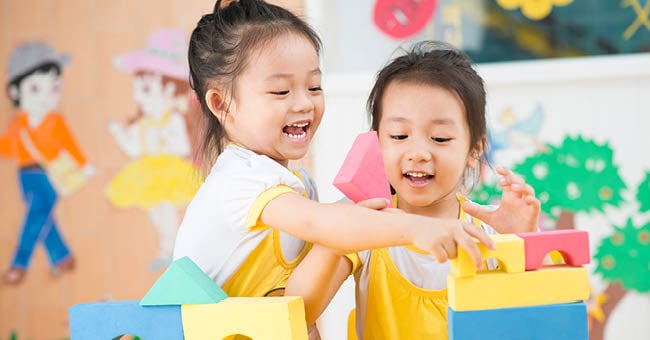
In this blog series, child psychologist and early education author Dr. Ginger Welch explores the issue of gender identity in early childhood education. Our first article, "Gender Identity in Preschool Children," discusses the ways gender-identity conversations happen in preschool settings.
Preschoolers exist in the most magical places where they can become dinosaurs, ballerinas, or race car-driving unicorns all in a single afternoon, and most adults are magical enough to go right along with them. But what happens when a little girl decides she wants to be the daddy in dramatic play and insists she is a boy, or when a male child seems to always want to wear the prettiest, frilliest tutu in the room? Even seasoned teachers might find uneasiness creeping up as they wonder, "Should I correct this behavior?" Questions about gender and sex can make grown-ups uncomfortable, but young children are still exploring what it means to be a boy or a girl and what that means for careers, clothing, and daily activities. They are thinking in very concrete terms about what it means to be male or female. Children may think that having your hair in a bun makes you a girl or wearing pants makes you a boy, for instance. Teachers are in a unique position to help children think beyond stereotypical gender limitations and explore the meaning behind the roles that they see.
Conversation Examples
Consider some of these overheard preschool conversations, each paired with a stereotypical answer and a more open-ended response:
Example #1
CHILD: Mary and I both want to be the mommy. We can't have two mommies!
STEREOTYPED RESPONSE: One of you will have to be the baby or find another place to play.
OPEN-ENDED RESPONSE: What would a house with two mommies be like?
Example #2
CHILD: When I grow up, I want to marry my daddy.
STEREOTYPED RESPONSE: You're not allowed to do that.
OPEN-ENDED RESPONSE: What do you love about your daddy?
Example #3
CHILD: You can't wear that. You're a boy!
STEREOTYPED RESPONSE: Why don't you wear this coat? That's a good outfit for a boy.
OPEN-ENDED RESPONSE: What happens if David puts on the dress?
There are lots of "right" ways to respond to the children, but the important thing in each response is to reinforce the child and elicit the child's feelings or thoughts. We're not advocating that a child grows up to marry her father, for instance. We know, however, that this is a typical preschool desire in which "love" and "marriage" are combined. Instead, we help the child focus on what is good about her relationship with her father. Teaching children that opportunities are not limited by gender is an important early lesson.
About the Author
Dr. Ginger Welch is a former early childhood educator and current licensed psychologist and infant-mental-health mentor who has provided early intervention and early childhood mental-health services for over twenty years. As a full-time clinical associate professor at Oklahoma State University, she conducts research on early childhood trauma and child maltreatment and routinely presents at national conferences, including the National Association for the Education of Young Children and Zero to Three. Dr. Welch is the author of the resource books How Can I Help? A Teacher's Guide to Early Childhood Behavioral Health and The Neglected Child: How to Recognize, Respond, and Prevent.
Explore This Series
Gender Identity in Preschool Children Part 2: Communicating Inclusively with Parents and CaregiversGender Identity in Preschool Children Part 3: Uncomfortable Questions
